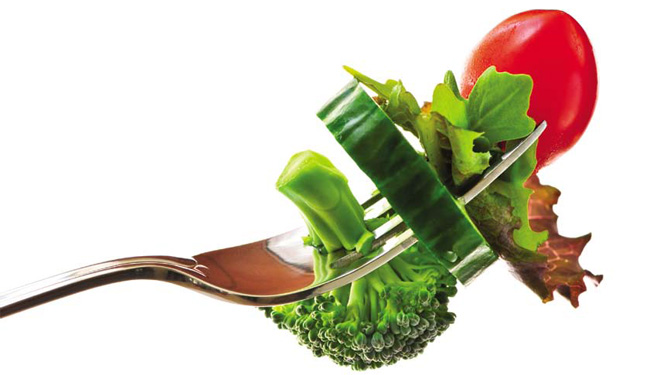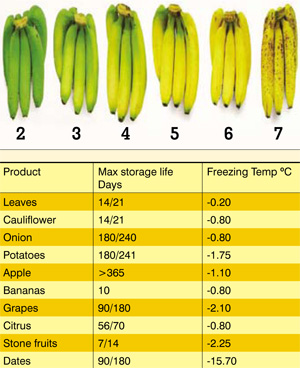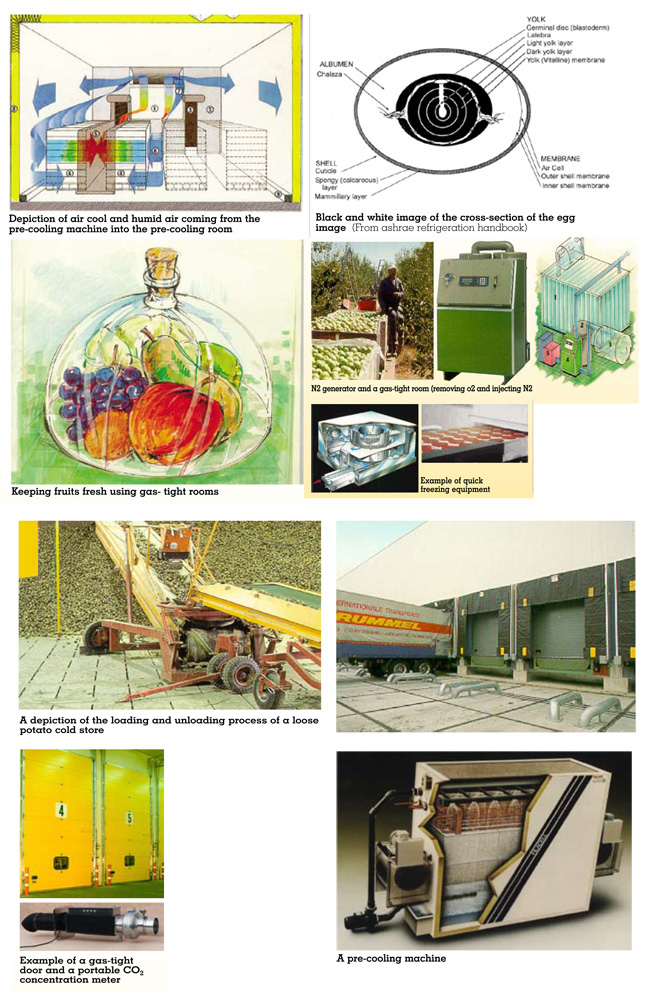What we eat traverses great distances. Safeguarding against contamination & disease is the onus of everybody involved.
In this era of globalisation, we no longer depend entirely on indigenous food products. What we eat, therefore, traverse great distances. Safeguarding it against contamination and disease is the onus of everybody involved in the process, at all stages, argues Ghaleb Abusaa.

The nature of modern life dictates that heavily populated cities and communities are dependent upon remote farms and rural communities that are usually far away from their locations, for their food supplies.
Refrigerated fleets with proper packing and packaging are absolutely necessary in order to transport such food items across long distances, while keeping them fresh and in good condition. It is, therefore, important to have cold storage facilities at both ends – the point of origin and at the consumers’ end – to meet the huge demand for seasonal food.
Fortunately, thanks to the availability of excellent air, sea and land cargo systems, not to mention a satellite view of the globe, it is now possible and easy to supply food stuff to far off communities that can afford the cost. Thus, most communities can now enjoy food they like, from anywhere in the world, all round the year, in as fresh and tender a condition as it was, in the country of origin or production.
Also, all kinds of meat (red meat, poultry and sea food) are available in fresh, refrigerated and frozen conditions, using refrigeration systems under tight and precise health regulations, to keep them edible and free from disease.
Following are a few examples:
Fruits and vegetables:
Nutrition in fruits and vegetables is subject to loss during their growth period and after maturity, even before they are harvested. But such losses are compensated for by the mother tree or plant. However, after being harvested, the fruit stays alive and the seed starts to feed on it, causing the fruit to ferment and deteriorate. There are other causes for the decay, too, such as the effect of ethylene at increased rates, due to stress, temperature and the presence of oxygen.
Reducing the ethylene level of a fruit or vegetable reduces the rate of fermentation, the temperature and the oxygen level, thus decreasing the germ or seed activity. This, in turn, keeps the rate of decay in check.
Also, as water contributes to a major part of the weight of fruits and vegetables, it is necessary to reduce their weight loss caused by evaporation of water. The evaporation rate increases under high temperature and dry air conditions.
It is evident that we need to reduce the temperature and oxygen content and raise the humidity level as much as possible, when we transport food stuff. This is exactly what a cold storage does.
GUIDELINES FOR STORAGE OF FRUITS AND VEGETABLES
Store each type under the following recommended conditions:
» Do not store green-coloured vegetables with coloured fruits, as coloured fruits emit more ethylene and cause fermentation quickly.
» Do not ripen bananas except when they are ready to be sold and eaten in a few days.
» Chill fruits and vegetables as quickly as possible after harvesting. They lose most of their shelf-life and quality in the first few hours after harvesting, if not cooled quickly. (This is cold pre/fast cooling.)
Reduce the oxygen content in the room as quickly as possible for the long-term storage of some fruits, like grapes and apples, and keep the rooms gas-tight. This process is called Ultra-low Oxygen (ULO) atmosphere.
Inject nitrogen into the rooms instead of oxygen.
FREEZING
Freezing does not kill germs but forces them to sleep. Once the temperature rises, the germs become active, leading to the process of deterioration. This process is evident in nature, in cold countries, when the land turns green once winter is over, and spring starts. This is because all the germs and seeds in the ground start growing. Similarly, freezing meat, poultry and fish keeps them edible. Once they are defrosted, it is not advisable to freeze them again. They have to be cooked and eaten immediately. This is necessary, not only to preserve their taste but also to keep them edible. Thus, quick “fast” freezing is a must.
PASTEURISING, FUMIGATION AND STERILISATION
These three terms have a similar connotation but are usually applied to different products.
 As stated earlier, germs cannot be killed by dropping the temperature but can only be forced to sleep. To kill them, we must raise the temperature to a very high degree. This is called pasteurisation. Once the milk arrives at the dairy plant, it is pasteurised to kill the germs by raising the temperature to nearly boiling temperatures (below boiling). This is because it starts deteriorating after milking, if not cooled immediately, as bacteria grow very quickly under warm conditions. Thus, cooling the milk starts at milking parlours with CIP arrangements. The milk is, then, transported in cool containers to processing factories.
As stated earlier, germs cannot be killed by dropping the temperature but can only be forced to sleep. To kill them, we must raise the temperature to a very high degree. This is called pasteurisation. Once the milk arrives at the dairy plant, it is pasteurised to kill the germs by raising the temperature to nearly boiling temperatures (below boiling). This is because it starts deteriorating after milking, if not cooled immediately, as bacteria grow very quickly under warm conditions. Thus, cooling the milk starts at milking parlours with CIP arrangements. The milk is, then, transported in cool containers to processing factories.
Fumigation is a term used to kill germs and seeds either by steam (high temperature) or by eliminating oxygen by N2 or CO2, thus killing the germs by inducing the absence of oxygen. This is used mainly in dates and potato cold stores.
Steriliation serves a similar purpose, but the process is used for packing and in containers that store/transport products, such as canned food and long-life dairy products. Such containers have to fulfill other conditions, too. For example, the material should not react with the products or deteriorate under varying storage temperatures.
CHICKEN EGGS
Chicken and eggs are two of the most widely used food products but the least understood by consumers. It is easy for consumers to examine the egg externally, to know the age and how good the egg is. But how good it had been at the time of storing and how it was handled till its arrival is a vast and interesting subject, and merits a separate article.
MILESTONES OF THE TRIP FROM THE SOURCE TO YOUR TABLE
It is important to spare a thought to the journey a food product makes from its source to the consumers, and the effect the journey has on the quality and shelf-life of the product. It is equally important to follow certain recommendations in order to preserve its quality and increase its shelf-life.
Regardless of whether it is fruit, vegetable, meat, eggs, canned food or a dairy product, the food we eat goes through a series of milestone events that need to be supervised professionally and correctly, to ensure that it arrives at our table in as good a condition as it is possible. Misuse of the product or inefficiency in handling it at any of these milestones along the journey, affect its quality. Following are the important milestones:
» If it is a plant product, the manner in which it was grown at the point of origin; whether the product was from a plant fed by organic or non-organic fertiliser; the quality of soil in which the plant was grown and the water used
» If it is livestock for meat, eggs and the like, the manner in which the livestock was raised
» The way in which a plant product was harvested, collected, treated, cooled or frozen and packed at the source
» The way it has been transported and the environments and temperatures which it was subjected to during transportation
» Sample cold store with dock shelters hugging the refrigerated truck
» The way in which it was handled at the wholesale storage facility before it was distributed to the outlets
» The way it was transported and distributed to the outlets
» The way in which the outlets stored it and the shops handled and displayed it at their facilities in preparation for the consumers to buy it
» Finally, how we handle it at our homes before we serve it, whether fresh or cooked
Educating and raising awareness of the public about the importance of such subjects is the key to cleaner and more hygienic food. The media could play an important role in this regard.
HEALTH AND SAFETY
Although quality and taste play a big role in the food industry, from the perspective of the consumers, health and safety concerns are the two most important factors that govern the sector. The onus of ensuring them rests on the shoulders of the concerned authorities. By the nature of things, in the normal course, this is an area that the general public hardly gets a peek into.
Each country has its own set of regulations in place in order to safeguard its people against possible danger and diseases that food can cause, especially considering the fact that food crosses borders across countries every minute. It is, therefore, the responsibility of the consumers and those involved in the food chain business, to follow guidelines and instructions in this regard very strictly and meticulously. Raising awareness of everyone involved is also equally necessary.
The writer is the CEO of en3 Solutions (The Three Factors Company), Jordan. He can be contacted at g.abusaa@en3solutions.com.

Copyright © 2006-2025 - CPI Industry. All rights reserved.